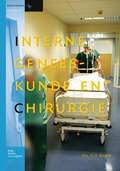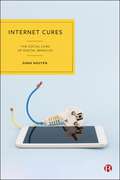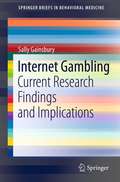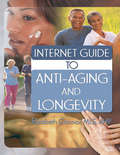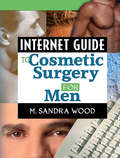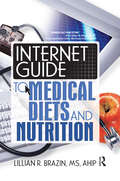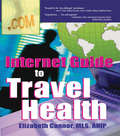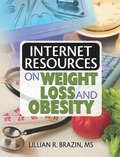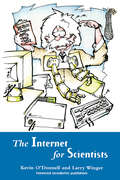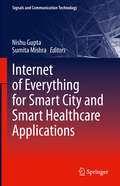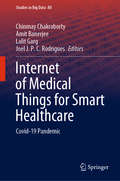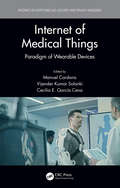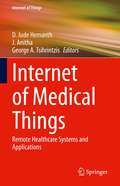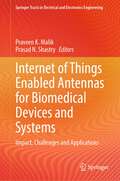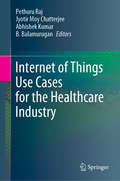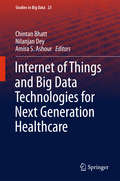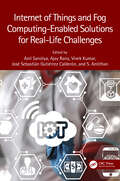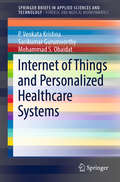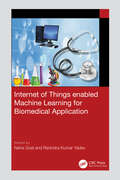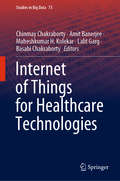- Table View
- List View
Interne geneeskunde en chirurgie
by Ij. D. JüngenIn dit boek wordt de basis gelegd voor een goed begrip voor de interne en chirurgische ziektebeelden, samen met de basiswerken Anatomie en fysiologie en Algemene ziekteleer, die hierop aansluiten.et toedienen, verdunnen en oplossen van geneesmiddelen in de patiëntenzorg. Het boek begint met het hoofdstuk medisch meedenken. Bij alle onderdelen van het diagnostisch proces spelen verpleegkundigen een belangrijke rol. Aan de hand van casuïstiek wordt verhelderd hoe het diagnostisch proces verloopt en hoe verpleegkundigen hierin een rol kunnen en moeten spelen. In de volgende hoofdstukken worden de verschillende meest voorkomende ziektebeelden met hun verschijnselen, complicaties en behandeling naar orgaansysteem beschreven. Steeds wordt geprobeerd om de verschijnselen en complicaties vanuit de fysiologie te verklaren, zodat de verpleegkundigen beter kunnen observeren (wat kan men observeren, hoe kan men observeren en met welk doel wordt geobserveerd) en daardoor beter kunnen signaleren en beredeneren welke verpleegkundige interventies noodzakelijk zijn.
Internet Cures: The Social Lives of Digital Miracles
by Dang NguyenIn health care, we come across daily promises of miraculous cures for various ailments. However, in the digital era, the dynamics of experiencing and practicing these remedies have changed. This book explores the intersection of miracle cures and technology, showcasing their transformation into hybrid forms, such as handwritten recipes captured in photos or tutorials streamed through videos. Combining computational social media data with ethnographic insights from Vietnam and the US, the book captures the interconnected lives of these cures in the digital realm with a unique methodology. Unravelling the intricate connections between social, technological, biomedical and non-biomedical spheres, this is a significant contribution to how social scientists study online media.
Internet Gambling
by Sally GainsburyInternet gambling is one of the fastest growing forms of gambling. Global Internet gambling expenditure is predicted to reach US$33.6 billion in 2011. This is higher than worldwide movie box office revenues and represents 9% of the international gambling market. The rapid increase in expenditure of 354% since 2003 has occurred despite Internet gambling being prohibited in several key markets, including the US and China. It also suggests that current regulation may be somewhat outdated and ineffective as more and more people turn to this mode of gambling. Internet gambling is highly accessible with over 2,400 sites available 24/7 through computers, mobile phones, wireless devices and even interactive televisions. Gamblers can now play casino games, bingo, cards and poker, bet on races, sports and even celebrity weddings using over 199 means of electronic payments without leaving the house. Increasing international jurisdictions are legalizing Internet gambling and the constant accessibility of online gambling has critical social implications. Gambling operators are using aggressive advertising campaigns to move into new markets. Internet gambling appears to be particularly appealing to youth, who are gambling online at substantially higher rates than adults. Furthermore, Internet gambling appears to be related to problem gambling, with rates of problem gambling three to four times higher among Internet than non-Internet gamblers, indicating that it may have a substantial social cost. The anonymity of online sports betting poses a significant threat to the integrity of sport at all levels with increasing allegations of match-fixing and cheating. Estimates suggested that 50% of all bets on the 2010 FIFA World Cup were placed online, worth an estimated £500 million. These figures represent a 700% rise in online betting since the 2006 tournament and included many new players that opened online accounts. It is essential that appropriate responses are made by governments, industry professionals and the public in response to Internet gambling. This book will provide a comprehensive and up-to-date overview of Internet gambling, including the social impact and regulatory options. A global outline will include the characteristics and features of the many forms of Internet gambling, including the current market, and participation, and differences between Internet and non-Internet gambling. Specific regional considerations will be explored including regulatory responses and options. Importantly, the social consequences and costs of Internet gambling will be examined, including the impact of online gambling on sports, youth and problem gambling. Strategies for prevention and responsible gambling will be considered as well as expected trends.
Internet Guide to Anti-Aging and Longevity
by Elizabeth ConnorQuickly and easilyfind anti-aging and health strategies on the Internet Even the most sophisticated Web surfer can become frustrated searching for specific health information on the Internet. The Internet Guide to Anti-Aging and Longevity tackles this problem by providing a comprehensive compilation of annotated links on health,
Internet Guide to Cosmetic Surgery for Men
by M. Sandra WoodSave time and trouble as you search the Internet for safe and reliable information on cosmetic procedures In a culture where everyone wants to look younger, more and more men are going under the knife for surgical cosmetic procedures in an effort to turn back the clockor at least slow it down a little. The Internet
Internet Guide to Cosmetic Surgery for Women
by M Sandra WoodLearn to use the Internet to find important information on cosmetic surgery procedures-and the right surgeon to do it!Hundreds of thousands are considering cosmetic surgery of some sort. The question is where can you go to find out what is right for you? The Internet Guide to Cosmetic Surgery for Women gives you the advantage of finding out everything you want to know about cosmetic surgery-from the comfort and privacy of your own home. This comprehensive resource guides you through the mountains of information on the Internet, providing a thorough listing of Web sites detailing every aspect of plastic and cosmetic surgery for every body part, as well as presenting strategies for finding specific information you are looking for. The Internet Guide to Cosmetic Surgery for Women gives you the tools to find information about a specific procedure, learn the surgery&’s advantages as well as risks-even how to locate the best surgeons for the procedure. The book provides screen shots to illustrate Web sites, information on where to find the latest important statistics and data, and helpful definitions for cosmetic surgery terms.The Internet Guide to Cosmetic Surgery for Women not only lists Internet addresses and basic sites on cosmetic surgery, but also reveals where to find quality information on: the costs of surgery selecting a cosmetic surgeon liposuction calf implants tummy tucks thigh lifts buttock liposculpture buttock augmentation belt lipectomy breast surgeries, including enlargement, lifts, reconstruction, and reduction cheek implants facelifts jaw augmentation laser skin resurfacing lip augmentation nose surgery cellulite treatment Botox injections hair removal hair transplantation scar revision wrinkle treatment chemical peels cosmetic dentistry and much more!The Internet Guide to Cosmetic Surgery for Women is an essential guide for anyone interested in or considering plastic and cosmetic surgery procedures.
Internet Guide to Medical Diets and Nutrition
by Lillian BrazinDon't waste you time with health and diet Web sites that don’t work. The Internet provides unlimited resources that make it easy to learn about various diets, weight-loss programs, and weight-reduction procedures. But with so many sources, which ones can you trust for information that’s safe, accurate, and up-to-date? The Internet Guide to Medical Diets and Nutrition saves you time, trouble, and effort in your search for Web sites that offer the facts about diet programs and nutrition philosophies that meet your health, medical, or religious needs. The Internet Guide to Medical Diets and Nutrition helps you filter out Web sites that offer little, if any, real help in maintaining special diets that address specific diseases (low protein, high calcium, low gluten, hypoallergenic, diabetes, cancer, anemia, etc.), religious or philosophical mandates (Hindu, kosher, vegan, Muslim, macrobiotic, etc.), or commercial regimens (Atkins™, Weight Watchers®, NutriSystem®, etc.), or provide answers to questions about bariatric surgery (gastric bypass, stomach stapling, etc.). This invaluable reference resource teaches you how locate Web sites recommended to you, how to evaluate the information you find there, how to research a particular diet or health concern, how to choose and use the right search engine, the significance of domains in Web addresses, and how to observe proper etiquette when participating in Internet discussion groups. Topics examined in the Internet Guide to Medical Diets and Nutrition include: general diet and nutrition Web sites Web calculators (Body Mass Index, exercise, calories, weight-maintenance, healthy weight) the nutrient content of foods food labels non-surgical weight-loss Web sites caloric restrictions hypnosis weight-loss centers and workshops weight-loss surgery Web sites Web sites for specific medical conditions vegetarianism recipes online discussion groups and much more! The Internet Guide to Medical Diets and Nutrition also includes a glossary of terms and screen captures of important Web sites. The book is a must-have as an everyday resource for consumers with diet and health interests and concerns, and as a reference tool for medical and public libraries.
Internet Guide to Pet Health
by Elizabeth ConnorWith the staggering amount of pet health information available on the Internet, it is often difficult to find exactly what you are looking for. The Internet Guide to Pet Health is a one-stop guide that weeds through all the clutter to bring you only the most dependable sources and relevant content. This comprehensive compilation of annotated links will serve as a handy, useful, and easy-to-consult guide for persons who appreciate animals and/or own domestic pets of all kinds, especially cats and dogs. This text also features a full glossary of medical terms, bibliography, and a quick-find index.The health needs of pet animals have become as complex and specialized as those of humans. Pet owners, veterinarians, and animal lovers alike need authoritative, reliable, and up-to-date information about caring for the health and well-being of pets. The Internet Guide to Pet Health offers a quick, easy, and comprehensive reference to quality Web sites that focus on the health and welfare of animal companions. The Internet Guide to Pet Health will help you pinpoint reliable information on: • the health benefits of pet ownership • diseases transmitted by pets • pet food safety • animal care and welfare societies and organizations • death, dying, and euthanasia • poisons, dangerous situations, and other hazards • spaying and neutering • traveling with pets • pet-specific care for dogs, cats, small animals, and fish • surgery, surgical procedures, and hospitalization • exercise and training • dental care, diet, and nutrition • disabled pets • service and therapy animals • and much, much more! The Internet Guide to Pet Health is an ideal resource for anyone who is directly involved in the lives of pet companions or simply an animal lover. Medical librarians in academic medical centers and teaching hospitals; consumer health and public librarians; veterinarians and veterinary clinic staff; public health personnel; animal trainers; and groomers will also find this to be an invaluable text.
Internet Guide to Travel Health
by Elizabeth ConnorDiscover the best Web sites for you and your family&’s well-being while traveling! The Internet Guide to Travel Health is your one-stop resource for when you need authoritative, reliable, and up-to-date information for preventing or dealing with illness and injury while traveling in the United States and abroad. For persons traveling near or far, this useful, easy-to-consult guide identifies dependable Web sites with advice, tips, and accurate facts on health issues that can affect your travel plans. You&’ll save time and effort when researching the planning, preparation, and preventive measures necessary to stay healthy while traveling. In the Internet Guide to Travel Health, you will discover a wealth of information for maintaining your health and safety throughout your trip. This book offers you Web sites to keep you informed on the latest life-threatening situations occurring throughout the world, such as disease outbreaks, epidemics, and natural disasters. With Internet addresses for what health documents to keep with you at all times, how to find doctors and clinics at your destination, and even what to do in case of a death far from home, this informative guide helps you stay organized, even in an emergency. The Internet Guide to Travel Health provides you with reliable information on: elective and compulsory immunizations, vaccinations, and examinations safety concerns with specific modes of travel-automotive, railways, air travel, cruise ships travel recommendations and accommodations for people with disabilities, seniors, children, people with HIV, and pets specific diseases, conditions, and ailments that can affect travel or be encountered while traveling-from air rage and allergies to West Nile Virus and Yellow Fever interactive tools and real-time travel advice-driving distance calculators, air flight arrival/departure delays, and traffic reports In addition to the Web site listings, the Internet Guide to Travel Health provides numerous screen shots of key Internet resources and an understandable glossary of health- and Internet-related terms. With the myriad of health and safety risks associated with traveling both nationally and internationally, this book is essential for vacationers, business travelers, explorers, and health care professionals who want to stay informed and prepared.
Internet Resources on Weight Loss and Obesity
by Lillian BrazinA seasoned medical librarian provides top Internet resources on health, eating, and nutrition!Obesity has reached epidemic proportions not only in the United States, but also around the world. How does someone with weight loss questions find the most up-to-date information available to make informed health decisions? Internet Resour
Internet for Scientists
by Kevin O'Donnell Larry WingerThis book provides a straightforward manual and review handbook for accessing and using the resources of the Internet in the day to day labours of the working scientist. It addresses the problem of how to cope with an army who have discovered a whole new toy shop full of goodies.
Internet of Everything for Smart City and Smart Healthcare Applications (Signals and Communication Technology)
by Nishu Gupta Sumita MishraThis book provides an insight on the importance that the Internet of Things (IoT) and Information and Communication Technology (ICT) solutions can offer towards smart city and healthcare applications. The book features include elaboration of recent and emerging developments in various specializations of curing health problems; smart transportation systems, traffic management for smart cities; energy management, deep learning and machine learning techniques for smart health and smart cities; and concepts that incorporate the Internet of Everything (IoE). The book discusses useful IoE applications and architectures that cater to critical knowledge creation towards developing new capacities and outstanding economic opportunities for businesses and the society.
Internet of Medical Things for Smart Healthcare: Covid-19 Pandemic (Studies in Big Data #80)
by Amit Banerjee Joel J. P. C. Rodrigues Chinmay Chakraborty Lalit GargThis book covers COVID-19 related research works and focuses on recent advances in the Internet of Things (IoT) in smart healthcare technologies. It includes reviews and original works on COVID-19 in terms of e-healthcare, medicine technology, life support systems, fast detection, diagnoses, developed technologies and innovative solutions, bioinformatics, datasets, apps for diagnosis, solutions for monitoring and control of the spread of COVID-19, among other topics. The book covers comprehensive studies from bioelectronics and biomedical engineering, artificial intelligence, and big data with a prime focus on COVID-19 pandemic.
Internet of Medical Things: Paradigm of Wearable Devices (Internet of Everything (IoE))
by Vijender Kumar Solanki Manuel Cardona Cecilia E. GarcíaInternet of Things (IoT) has become a valuable tool for connection and information exchange between devices. This book provides a brief introduction to this new field, focuses on wearable medical devices, and covers the basic concepts by providing the reader with enough information to solve various practical problems. This book provides the latest applications, experiments, fundamentals concepts, and cutting-edge topics for the ehealth and wearable devices field. The book also offers topics related to Security in IoT and Wearable Devices, Wearable Devices and Internet of Medical Devices (IoMT), IoT for Medical Applications, and Tools and study cases. The book brings new and valuable information to PhD researchers, students, professors, and professionals working in IoT and related fields.
Internet of Medical Things: Remote Healthcare Systems and Applications (Internet of Things)
by George A. Tsihrintzis D. Jude Hemanth J. AnithaThis book looks at the growing segment of Internet of Things technology (IoT) known as Internet of Medical Things (IoMT), an automated system that aids in bridging the gap between isolated and rural communities and the critical healthcare services that are available in more populated and urban areas. Many technological aspects of IoMT are still being researched and developed, with the objective of minimizing the cost and improving the performance of the overall healthcare system. This book focuses on innovative IoMT methods and solutions being developed for use in the application of healthcare services, including post-surgery care, virtual home assistance, smart real-time patient monitoring, implantable sensors and cameras, and diagnosis and treatment planning. It also examines critical issues around the technology, such as security vulnerabilities, IoMT machine learning approaches, and medical data compression for lossless data transmission and archiving. Internet of Medical Things is a valuable reference for researchers, students, and postgraduates working in biomedical, electronics, and communications engineering, as well as practicing healthcare professionals.
Internet of Things Based Smart Healthcare: Intelligent and Secure Solutions Applying Machine Learning Techniques (Smart Computing and Intelligence)
by Chuan-Ming Liu Biswaranjan Acharya Chandreyee Chowdhury Suparna BiswasThis book provides both the developers and the users with an awareness of the challenges and opportunities of advancements in healthcare paradigm with the application and availability of advanced hardware, software, tools, technique or algorithm development stemming the Internet of Things. The book helps readers to bridge the gap in their three understanding of three major domains and their interconnections: Hardware tested and software APP development for data collection, intelligent protocols for analysis and knowledge extraction. Medical expertise to interpret extracted knowledge towards disease prediction or diagnosis and support. Security experts to ensure data correctness for precise advice. The book provides state-of-the-art overviews by active researchers, technically elaborating healthcare architectures/frameworks, protocols, algorithms, methodologies followed by experimental results and evaluation. Future direction and scope will be precisely documented for interested readers.
Internet of Things Enabled Antennas for Biomedical Devices and Systems: Impact, Challenges and Applications (Springer Tracts in Electrical and Electronics Engineering)
by Prasad N. Shastry Praveen K. MalikThe book consists of the latest research in biomedical and communication integration. It discusses the fabrication and testing outcomes of the Internet of Things-enabled biomedical applications. The book focuses on recent advances in the field of planar antenna design and their applications in space communication, mobile communication, wireless communication, and wearable applications. Planar antennas are also used in medical applications in microwave imaging, medical implants, hyperthermia treatments, and wireless wellness monitoring. This book presents planar antenna design concepts, methods, and techniques to enhance the performance parameters and applications for IoT and device-to-device communication. It provides the latest techniques used for the design of antennas in terms of their structures, defected ground, MIMO, and fractal design. This book also addresses the specific steps to resolve issues in designing antennas and how to design conformal and miniaturized antenna structures for various applications.
Internet of Things Technologies for HealthCare
by Mobyen Uddin Ahmed Shahina Begum Wasim RaadThis book constitutes the proceedings of the Third International Conference on Internet of Things (IoT) Technologies for HealthCare, HealthyIoT 2016, held in V#65533;ster#65533;s, Sweden, October 18-19, 2016. The conference also included the First Workshop on Emerging eHealth through Internet of Things (EHIoT 2016). IoT as a set of existing and emerging technologies, notions and services provides many solutions to delivery of electronic healthcare, patient care, and medical data management. The 31 revised full papers presented along with 9 short papers were carefully reviewed and selected from 43 submissions in total. The papers cover topics such as healthcare support for the elderly, real-time monitoring systems, security, safety and communication, smart homes and smart caring environments, intelligent data processing and predictive algorithms in e-Health, emerging eHealth IoT applications, signal processing and analysis, and smartphones as a healthy thing.
Internet of Things Use Cases for the Healthcare Industry
by Pethuru Raj Abhishek Kumar Jyotir Moy Chatterjee B. BalamuruganThis book explores potentially disruptive and transformative healthcare-specific use cases made possible by the latest developments in Internet of Things (IoT) technology and Cyber-Physical Systems (CPS). Healthcare data can be subjected to a range of different investigations in order to extract highly useful and usable intelligence for the automation of traditionally manual tasks. In addition, next-generation healthcare applications can be enhanced by integrating the latest knowledge discovery and dissemination tools. These sophisticated, smart healthcare applications are possible thanks to a growing ecosystem of healthcare sensors and actuators, new ad hoc and application-specific sensor and actuator networks, and advances in data capture, processing, storage, and mining. Such applications also take advantage of state-of-the-art machine and deep learning algorithms, major strides in artificial and ambient intelligence, and rapid improvements in the stability and maturity of mobile, social, and edge computing models.
Internet of Things and Big Data Technologies for Next Generation Healthcare
by Nilanjan Dey Chintan Bhatt Amira S. AshourThis comprehensive book focuses on better big-data security for healthcare organizations. Following an extensive introduction to the Internet of Things (IoT) in healthcare including challenging topics and scenarios, it offers an in-depth analysis of medical body area networks with the 5th generation of IoT communication technology along with its nanotechnology. It also describes a novel strategic framework and computationally intelligent model to measure possible security vulnerabilities in the context of e-health. Moreover, the book addresses healthcare systems that handle large volumes of data driven by patients' records and health/personal information, including big-data-based knowledge management systems to support clinical decisions. Several of the issues faced in storing/processing big data are presented along with the available tools, technologies and algorithms to deal with those problems as well as a case study in healthcare analytics. Addressing trust, privacy, and security issues as well as the IoT and big-data challenges, the book highlights the advances in the field to guide engineers developing different IoT devices and evaluating the performance of different IoT techniques. Additionally, it explores the impact of such technologies on public, private, community, and hybrid scenarios in healthcare. This book offers professionals, scientists and engineers the latest technologies, techniques, and strategies for IoT and big data.
Internet of Things and Fog Computing-Enabled Solutions for Real-Life Challenges
by Vivek Kumar Ajay Rana Anil Saroliya Gutiérrez Calderón, José SebastiánIn today’s world, the use of technology is growing rapidly, and people need effective solutions for their real-life problems. This book discusses smart applications of associated technologies to develop cohesive and comprehensive solutions for the betterment of humankind. It comprehensively covers the effective use of the Internet of Things (IoT), wireless sensor network, wearable sensors, body area network, cloud computing, and distributed computing methodologies. The book comprehensively covers IoT and fog computing sensor supported technologies or protocols including web of things, near-field communication, 6LoWPAN, LoRAWAN, XMPP, DDS, LwM2M, Mesh Protocol, and radio-frequency identification. The book- Discusses smart applications to develop cohesive and comprehensive solutions for real-life problems. Covers analytical descriptions with appropriate simulation and prototype models. Examines the role of IoT and fog computing technologies during global emergency situations. Discusses key technologies including cloud computing, 5G communication, big data, artificial intelligence, control systems, and wearable sensors. The text is primarily written for graduate students, and academic researchers working in diverse fields of electrical engineering, biomedical engineering, electronics and communication engineering, computer engineering, and information technology.
Internet of Things and Personalized Healthcare Systems (SpringerBriefs in Applied Sciences and Technology)
by Mohammad S. Obaidat Sasikumar Gurumoorthy P. Venkata KrishnaThis book highlights the issues and challenges in personalised healthcare systems. The individual chapters address different aspects of such systems, including the novel Internet of Things (IoT) system architectures in healthcare and emerging e-health based IoT applications. Moreover, the book investigates the impact of cutting-edge innovations on the IoT.
Internet of Things enabled Machine Learning for Biomedical Application
by Neha Goel Ravindra Kumar YadavThe text begins by highlighting the benefits of the Internet of Things-enabled machine learning in the healthcare sector, examines the diagnosis of diseases using machine learning algorithms, and analyzes security and privacy issues in the healthcare systems using the Internet of Things. The text elaborates on image processing implementation for medical images to detect and classify diseases based on magnetic resonance imaging and ultrasound images.This book:· Covers the procedure to recognize emotions using image processing and the Internet of Things-enabled machine learning.· Highlights security and privacy issues in the healthcare system using the Internet of Things. · Discusses classification and implementation techniques of image segmentation.· Explains different algorithms of machine learning for image processing in a comprehensive manner. · Provides computational intelligence on the Internet of Things for future biomedical applications including lung cancer.It is primarily written for graduate students and academic researchers in the fields of electrical engineering, electronics and communications engineering, computer science and engineering, and biomedical engineering.
Internet of Things for Healthcare Technologies (Studies in Big Data #73)
by Amit Banerjee Maheshkumar H. Kolekar Chinmay Chakraborty Lalit Garg Basabi ChakrabortyThis book focuses on recent advances in the Internet of Things (IoT) in biomedical and healthcare technologies, presenting theoretical, methodological, well-established, and validated empirical work in these fields. Artificial intelligence and IoT are set to revolutionize all industries, but perhaps none so much as health care. Both biomedicine and machine learning applications are capable of analyzing data stored in national health databases in order to identify potential health problems, complications and effective protocols, and a range of wearable devices for biomedical and healthcare applications far beyond tracking individuals’ steps each day has emerged. These prosthetic technologies have made significant strides in recent decades with the advances in materials and development. As a result, more flexible, more mobile chip-enabled prosthetics or other robotic devices are on the horizon. For example, IoT-enabled wireless ECG sensors that reduce healthcare cost, and lead to better quality of life for cardiac patients. This book focuses on three current trends that are likely to have a significant impact on future healthcare: Advanced Medical Imaging and Signal Processing; Biomedical Sensors; and Biotechnological and Healthcare Advances. It also presents new methods of evaluating medical data, and diagnosing diseases in order to improve general quality of life.
Internet of Things for Human-Centered Design: Application to Elderly Healthcare (Studies in Computational Intelligence #1011)
by Sofia Scataglini Gonçalo Marques Silvia ImbesiThe book presents the state of the art of the Internet of Things (IoT), applied to Human-Centered Design (HCD) projects addressed to ageing users, from the perspective of health, care and well-being. The current focus on the ageing population is opening up new opportunities for the development of niche solutions aimed at the niche category of older users who are beginning to experience physical and cognitive decline but are still independent and need to maintain their autonomy for as long as possible. The combination between the needs expressed by older users and the opportunities offered by the recent innovative technologies related to the Internet of Things allows research institutions, stakeholders, and academia to target and design new solutions for older users, safeguarding their well-being, health, and care, improving their quality of life. This book discusses and analyses the most recent services, products, systems and environments specifically conceived for older users, in order to enhance health, care, well-being and improve their quality of life. This approach is coherent with the percept of AAL or enhanced living environment, looking to the users’ comfort, autonomy, engagement and healthcare. The book describes and analyses aspects of HCD with older users looking to the emerging technologies, products, services, and environments analysed in their actual application in different areas, always concerning the design for the elderly related to the IoT, just as the development of biomonitoring devices, tools for activity recognition and simulation, creation of smart living environments, solutions for their autonomy, assistance and engagement enhancing health, care and wellbeing. The book is intended for researchers, designers, engineers, and practitioners in healthcare to connect academia, stakeholders, and research institutions to foster education, research and innovation.
